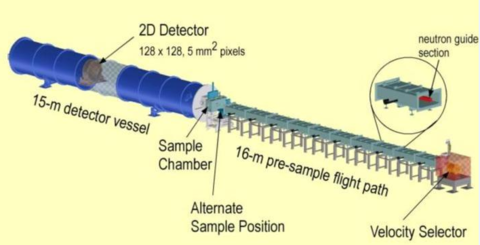NGB 30m SANS - Small Angle Neutron Scattering

The 30 meter SANS instrument is installed on a split neutron guide NG-B. Designed to cover a wide Q-range, from 0.01 nm-1 using focusing refractive lenses to nearly 8.5 nm-1 at the lowest neutron wavelengths, it is suitable for examining structural features in materials ranging from roughly 1 to 700 nm. At least 75% of the instrument time will be allocated to guest researchers by the Beam Time Allocation Committee (BTAC).
Specifications/Capabilities
|
Q-Range |
0.01 nm-1 to 8.5 nm-1 |
| Size Regime | ~1 nm to ~700 nm |
| Source | Neutron Guide (NG-B), cross-section: 60 mm x 60 mm |
| Monochromator | Mechanical velocity selector with variable speed and pitch |
| Wavelength Range | 3.0 Å to 20.0 Å |
| Wavelength Resolution | 10% to 30% Δλ/λ (FWHM) |
| Source-to-Sample Distance | 4 m to 16 m in 1.5m steps via insertion of guide sections |
| Collimation | Circular pinhole collimation or focusing biconcave lenses |
| Sample Size | 0 mm to 25 mm diameter |
| Sample-to-Detector Distance | 1.3 m to 13.1 m continuously variable |
| Detector |
640 mm x 640 mm 3He position-sensitive proportional counter with a 5.08 mm x 5.08 mm resolution |
| Optional Capabilities | Focusing biconcave lenses |
| Power Outlets |
220V, 30A, 1-phase - Qty. 2 208V, 30A, 3-phase - Qty. 2 208V, 60A, 3-phase - Qty. 2 110V, 30A, 1-phase - Numerous UPS and non-UPS |
Scientific Opportunities/Applications
How NGB 30m SANS Beam Time is Typically Allocated in Each 38 Day Cycle:
- 28 days minimum - BTAC Proposals
- Balance (10 days or less) - Proprietary and Collaborative Research
Created October 1, 2018, Updated October 12, 2023

